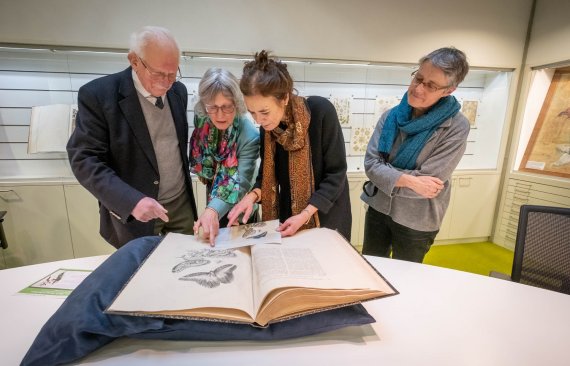The book by Merian (1647-1717) is titled Dissertatio sur la Generation et les Transformation des Insects de Suriname and contains 72 black-and-white prints of tropical insects and their host plants. The originally German artist and entomologist went on a study tour to Surinam at the age of 52. She was the first to draw both the insects and the plants they live on.
Original texts
The first print of the book came out in Amsterdam in 1705. The edition Lindenbergh has donated is a copy from 1726. According to the curator of Special Collections Forum, Liesbeth Missel, this is a Dutch edition with Latin and French texts. Missel is very happy with it. ‘We already have an edition from around 1765-70, but that one has no text. This book contains the original texts by Merian. That makes it exceptional.’

The history of the book and its various owners is equally exceptional. Jan Lindenbergh started studying Agricultural Engineering and Field and Grassland Agriculture in Wageningen in 1945, straight after the war. After graduating in 1951, he worked for the government service for land and water use, and later for Unilever.
Aristocratic family
The book by Merian came into his possession through his now deceased wife Anneke, a descendent of the De Jong family from Beek en Donk in the province of North Brabant. Lindenbergh lived in an old farmhouse a stone’s throw from Eyckenlust Castle in Beek en Donk, which had been the property of this aristocratic family since 1745. ‘The book lay in an old chest in the attic of the castle,’ he tells us. ‘It came to light when the attic was cleared, about 30 years ago now.
Het boek lag in een oude kist op de zolder van het kasteel
Jan Lindenbergh

My wife took it home. The book came into the family through the Nahuys family, who married into the De Jong family of Beek en Donk in the 19th century, says Lindenbergh. ‘Anna Nahuys was my wife’s great grandmother.’ In the front of the book is the coat of arms of ‘Countess Anna Nahuys’. She wasn’t actually a real countess. But she was a colourful, artistic and freethinking woman, as is clear from biography published in 2015 of her daughters, Cécile and Elsa, two feisty ladies.
Oosterbeek
Anna Nahuys (1826-1905) married Jan de Jong esquire, of Beek en Donk. Anna’s life, social setting and times, are minutely detailed in her diaries, filling 20 notebooks. Anna was the only child of a highly gifted father, and spoke five languages by the age of 12. Her mother was a talented painter of portraits and landscapes. After 1842, when Anna was 16, she spent the summers in Oosterbeek, where her mother painted and drew.
It is in good hands here in Wageningen
Jan Lindenbergh
It is possible that Anna Nahuys came to Wageningen during one of those summers. In any case, her book by Maria Sibylla Merian will reside here permanently from now on. ‘Because it is in good hands here,’ explains the generous donor, Lindenbergh. ‘I want the book preserved for posterity in a good, safe place.’
Lindenbergh has donated the book on condition it will not be sold, and that the family can always come and look through it, on request. WUR president Louise Fresco was more than happy to make these promises. She is a great admirer of the work of artist and scientist Merian.

 Jan Lindenbergh and his daughter look through Merian’s book with WUR president Louise Fresco. On the right, curator Liesbeth Missel of the WUR Library. Photo: Guy Ackermans
Jan Lindenbergh and his daughter look through Merian’s book with WUR president Louise Fresco. On the right, curator Liesbeth Missel of the WUR Library. Photo: Guy Ackermans